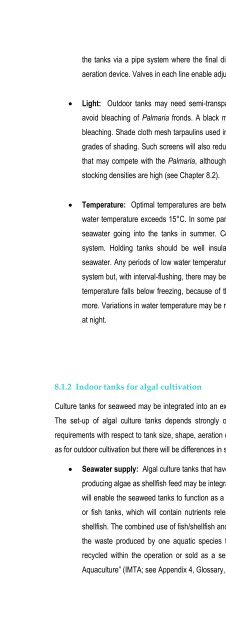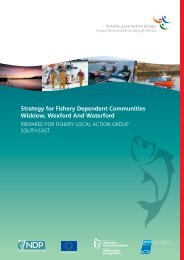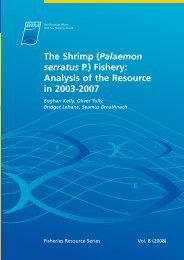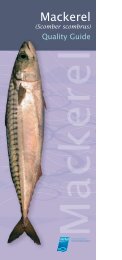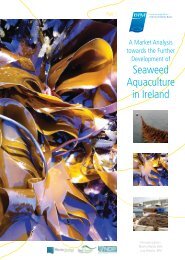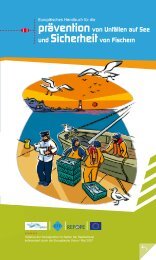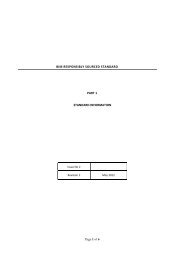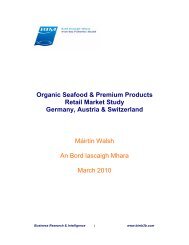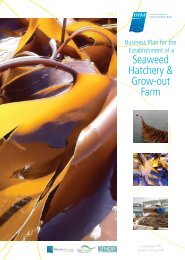Cultivating Palmaria palmata - Bord Iascaigh Mhara
Cultivating Palmaria palmata - Bord Iascaigh Mhara
Cultivating Palmaria palmata - Bord Iascaigh Mhara
You also want an ePaper? Increase the reach of your titles
YUMPU automatically turns print PDFs into web optimized ePapers that Google loves.
the tanks via a pipe system where the final diameter of the pipes is 2.0-2.5 cm when they reach the<br />
aeration device. Valves in each line enable adjustment of air flow into each individual tank (Fig. 8.2).<br />
Light: Outdoor tanks may need semi-transparent screens or blinds to reduce light levels and thus<br />
avoid bleaching of <strong>Palmaria</strong> fronds. A black mesh with small mesh size may be sufficient to prevent<br />
bleaching. Shade cloth mesh tarpaulins used in fish aquaculture are, for example, available in different<br />
grades of shading. Such screens will also reduce the growth of high-light requiring, opportunistic algae<br />
that may compete with the <strong>Palmaria</strong>, although such competitors should not be a problem if the initial<br />
stocking densities are high (see Chapter 8.2).<br />
Temperature: Optimal temperatures are between 8 and 12°C, and <strong>Palmaria</strong> will not grow well if the<br />
water temperature exceeds 15°C. In some parts of Ireland, therefore, it may be necessary to cool the<br />
seawater going into the tanks in summer. Cooling units can be inserted into the seawater supply<br />
system. Holding tanks should be well insulated in order to maintain the ambient temperature of<br />
seawater. Any periods of low water temperature in winter should not cause problems in a flow-through<br />
system but, with interval-flushing, there may be significant decreases in water temperature when the air<br />
temperature falls below freezing, because of the large surface area of tanks containing 1000 litres or<br />
more. Variations in water temperature may be reduced by double-walled tanks, or by covering the tanks<br />
at night.<br />
8.1.2 Indoor tanks for algal cultivation<br />
Culture tanks for seaweed may be integrated into an existing shellfish or fish farm with indoor cultivation tanks.<br />
The set-up of algal culture tanks depends strongly on the existing facilities and the space available. The<br />
requirements with respect to tank size, shape, aeration devices, temperature control and drainage are the same<br />
as for outdoor cultivation but there will be differences in seawater supply and light.<br />
Seawater supply: Algal culture tanks that have been installed in a shellfish hatchery for the purpose of<br />
producing algae as shellfish feed may be integrated into an existing seawater re-circulation system. This<br />
will enable the seaweed tanks to function as a water cleaning unit for the wastewater from the shellfish<br />
or fish tanks, which will contain nutrients released from the feed residues and faeces of the fish or<br />
shellfish. The combined use of fish/shellfish and seaweed species in one aquaculture operation permits<br />
the waste produced by one aquatic species to be transformed into a product, which can either be<br />
recycled within the operation or sold as a separate product. This is called “Integrated Multi-Trophic<br />
Aquaculture” (IMTA; see Appendix 4, Glossary, for further information).<br />
51


